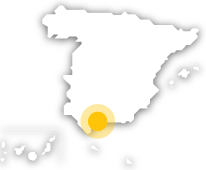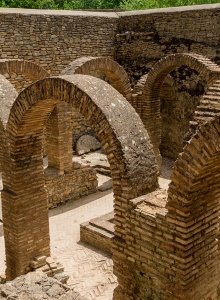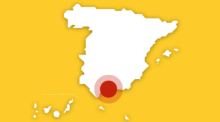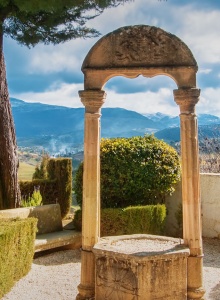This town in Malaga divides its urban area on both sides of the Tajo del Ronda, a gorge more than 100 metres deep. Its historic quarter has been declared a Property of Cultural Interest. Celts, Phoenicians, Romans and Arabs inhabited these lands, which were reconquered by the Catholic Monarchs.
The old quarter, with its reminiscences of Arab architecture and medieval layout, is spread over the south of the Guadalevín, while the more modern Ronda, which arose from the 16th century onwards, extends to the north of this riverbed. Various bridges connect these two halves of one of the most interesting towns on the White Villages Route, in the heart of the Serranía de Ronda, a few kilometres from the Costa del Sol.
The so-called “city of castles” stands on a natural watchtower defended, in its most accessible part, by a citadel. Its walls and the most important gates that gave access to the city are still preserved. The Almocábar gate (13th century) was the entrance to the urban area from the south end of the city, and the Carlos I gate dates from the 16th century, while the Exijara gate led to the Jewish quarter.The old citadelIn this walled environment, the Gothic-Renaissance construction of the Church of the Holy Spirit stands out, built by order of Ferdinand the Catholic to commemorate the reconquest of Ronda. Another important religious work is Santa María la Mayor, where Arab and Christian elements come together. On the site of an ancient Roman temple, the Arabs built the Great Mosque of Ronda in the 13th century. From this period, the mihrab arch, decorated with stucco, and the minaret, converted into a bell tower, remain. In the following centuries, its interior was enriched with Renaissance and Baroque decoration, as can be admired in its Main Chapel, choir and altars. The Mudejar style, with stuccos and horseshoe arches, is evident in the minaret of San Sebastián, later used for Christian worship. Another gem of Moorish heritage is the Arab baths, on the banks of the river. They date back to the 13th century and are very well preserved.Ronda's civil architecture takes the shape of stately homes and aristocratic palaces. The palaces of Mondragón and the Marquis of Salvatierra, and the Casa del Moro are some of the beautiful examples that can be admired. The first of the palaces served as the residence of Muslim and Christian kings for centuries, and today it houses the city's Archaeological Museum. In the former home of the Marquis of Salvatierra, a wrought iron balcony stands out in pure Ronda style. Meanwhile, the Casa del Rey Moro boasts Gothic-Mudéjar decoration and hanging gardens, declared an Artistic Garden. The Bandit Museum, the Hunting Museum and the Lara Museum are other attractions worth considering on this side of the Tajo de Ronda.The Arab Bridge, the Old Bridge and the New BridgeThree bridges span a ravine more than 100 metres deep and lead to the other end of the city. The Arab Bridge was built in the 14th century and served as the entrance to the old quarter. The so-called Old Bridge consists of a single arch about 10 metres in diameter. However, the most emblematic of them all is the New Bridge, a colossal work of engineering that links the neighbourhoods of the market and the city. It dates back to the 18th century and its foundations sit at the base of the ravine, reaching 98 metres in height and 70 metres in length at some points.The old Town Hall, now a Parador de Turismo, crowns the cliff and is a spectacular place to rest and enjoy the views. The Paseo de Blas Infante and the Mirador de los Reyes Católicos, near the bullring (one of the oldest in Spain), are good places to enjoy the scenery of the Guadalevín river. The most recent part of this area includes the Church of Nuestro Padre Jesús and the Shrine of the Virgen de Dolores. The church is in Gothic style, where a Renaissance bell tower stands out. In the chapel of the Virgin, the Mannerist sculptural groups that decorate its pillars attract attention.Ronda is decked out during its festivals, which are great opportunities to enjoy this region. The Pedro Romero Festival, bullfights and a flamenco festival, are important events, as are Holy Week, the Festivals of the Reconquest and the Pilgrimage to Nuestra Señora de la Cabeza.The white villages of Moorish origin in the Serranía de Ronda combine popular architecture with stunning natural landscapes. Other towns, however, are famous for their Phoenician (Jimena de Líbar) or Roman (Acinipo) ruins. The Moorish essence, among olive groves and vineyards, is the distinctive mark of Algatocín or Atajate. The Ronda region is located in the wet regions of Andalusia, where the botanical diversity creates spectacular landscapes, such as the Sierra de las Nieves National Park, the Sierra Bermeja and the Sierra Crestellina. The Malaga coast is just a stone's throw away, offering us a coastline where Benalmádena, Fuengirola, Marbella and Estepona are the most active leisure enclaves.









